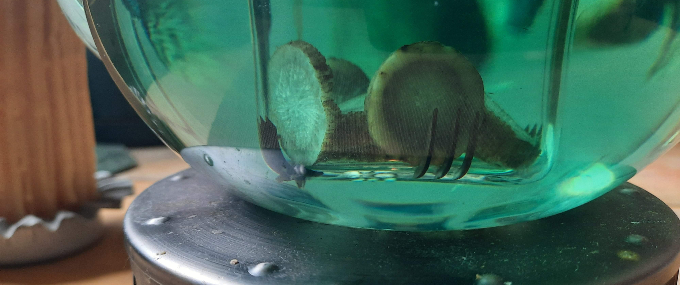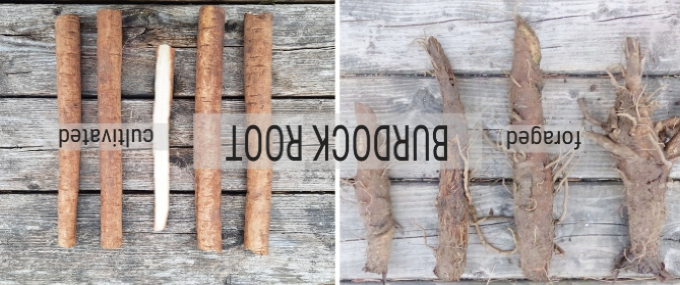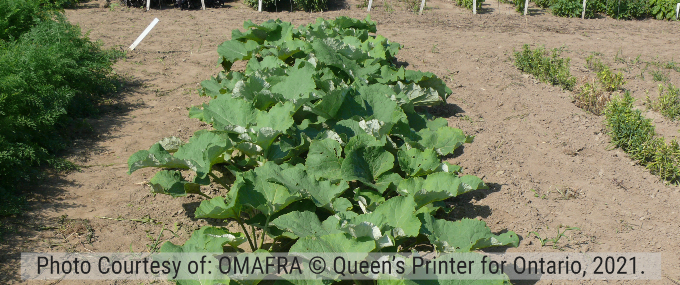Cultivated for thousands of years in Japan, gobo, perhaps recognized more so as being burdock, is an escaped domestic vegetable that has made its home in almost every country in the northern hemisphere. It also has found its way to Uruguay, Chile, Australia and perhaps other countries in the southern hemisphere.
Burdock – A Brief History
Wrongfully labeled as a weed, this valuable source of nourishment has the distinction of being used as food and medicine for hundreds of years and by many different cultures. It was considered to be sacred to the “heavenly bear”, Thor, by the early Celts and Germanic peoples. This Celt and Germanic belief made its way well into the Middle Ages as burdock was placed on gables to protect against lightning and “the machinations of giants”. In the late Middle Ages burdock was strung over doors or braided into hair to ward off evil. The Celts and Germanics also made a brew of burdock root to make the hair shiny. The use of burdock as a hair tonic continues today in many countries.
During World War II, there were reports of some Japanese prison guards who, out of good will, fed the prisoners of war burdock roots, which were a valuable source of nutrition during time where there was not enough to eat. It was believed that they later were accused of cruelty and subsequently jailed for many years.
According to the Japanese version of Wikipedia, after the end of the war, the directors of the 4th branch of the Tokyo POW Camp in Naoetsu Town (currently Joetsu City ) in Niigata Prefecture were accused of being “eaten the roots of trees” by the Australian POWs in the camp. These roots were not “of trees” – they were burdock.
In his 1996 book, Satoru Soma wrote, “In 1946, two POW camp officials were sentenced to death and three were sentenced to life imprisonment in a war crimes trial in Yokohama because they fed American prisoners of war with burdock. The Yokohama War Crimes Trials was a series of trials of Japanese war criminals, held before the military commission of the U.S. 8th Army at Yokohama immediately after the Second World War.
Name Origin
It is believed that burdock earned its Latin name, Arctium Lappa from two sources. The first part seems to originate from the Greek word arktos or “a bear” referring to its rough-coated fruits. The second part is from the Latin word lappare or “to seize”, referring to the burs that cling to animals or us in an attempt to propagate and spread its seed.
Valuable Food Source
Burdock packs a powerful punch loaded with nutrients and chemical constituents that provide us with a myriad of health benefits. Having burdock root fresh is best however dried and used as a tea also gives us an incredible boost to our immune system as well as other health benefits.
There are some chemicals in the root called polyacetylenes; they fight disease-causing bacteria and fungi. However, once dried, there are only trace amounts of polyacetylenes that remain.
Although the entire plant is technically edible, this does not mean that the taste is desirable. Leaves are best consumed when young because no matter how you prepare them when they get older, there isn’t much you can do to make them palatable. The seeds are packed with essential fatty acids as well as vitamins A and B2. The roots are by far the most revered by chefs and cooks worldwide.
Burdock root can grow anywhere from 30cm (12”) to 1 metre (3’) in length, and although somewhat slender, it has an almost carrot-like shape. The rough, thin skin ranges in colour from rusty beige to light brown and may be covered in smaller root hairs and marks across the surface. Underneath the skin, the flesh is dense, crisp, and pale white to ivory. Burdock root has a chewy and crunchy consistency with a mild, sweet, and earthy taste similar to artichoke. They are typically used in a variety of sautéed dishes but I enjoy them fresh as a crudité.
Growing Burdock
The idea of growing burdock may invoke fear in many, but the reality is that burdock root is a vegetable. When grown responsibly there is no fear of it spreading; this means to remove the flower heads before it goes to seed.
There are gobo farms not just in Japan but in many other areas worldwide because they are without a doubt a valuable, nutrient- dense vegetable. In fact, in the province of Ontario this plant, (Arctium lappa), is considered a specialty crop.
If growing or even foraging for this valuable food source does not appeal to you, then your best chance will be to forage for this in an Asian supermarket. It won’t be local burdock root, but it certainly is incredible to be able to enjoy this fresh vegetable throughout the year.
Eating this root vegetable may not appeal to everyone, so make a pot of tea with the fresh (or dried) root. Not only does this boast a pleasant earthy flavor, it produces a colour that is most pleasing.
Keep the history of burdock alive in your household and incorporate this into your diet. With so many nutrients and medicinal benefits, this truly is a magnificent plant.
Learn Detailed Information about Burdock
Over 20 pages of information is available through my PDF magazine on burdock. Learn all about the nutrient values, medicinal information, history, how to harvest, uses and recipes! To order your copy CLICK HERE!
For more basic information be sure to check the website!







An amazing plant that too many accused being a nuisance weeds. Little do these folks know that the virtues of this plant are way higher than the food they eat from a grocery store.